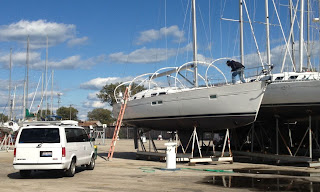By Andrew Spaulding
 |
| Beneteau Oceanis 45 - Stripes still on |
I wanted to detail some of the
projects that we are doing around the yard this winter. The Fiberglass Shop was
the logical place to start since we started the winter’s first hull paint job.
No to mention the differences in the before and after pictures can be quite
striking. With this in mind, Lakeside Story is going to follow the paint job of
a new Beneteau Oceanis 45 from the original factory gelcoat white to a dark blue.
The success of any paint job
hinges on the proper preparation of the surface. The first picture shows the
boat as it came from the factory with a vinyl boot stripe (the stripe that goes
along the water line) and a vinyl cove stripe (the stripe that is higher on the
hull below the gunwale). Once the vinyl stripes and other graphics are removed,
the hull needs to be washed and de-waxed perhaps several times if there is a
build up of wax on the boat.
The removal of the wax is
critical since the next step is sanding. If the boat is sanded with wax still
on it, the wax will be ground into the gelcoat making it very difficult to get
the primer and paint to stick to the hull. Once the hull is de-waxed and wiped
down with solvent to remove any lingering dirt or wax, it can be sanded to
remove surface imperfections. Since this boat is new, there are very few
imperfections that need to be repaired before the primer can be applied.
 |
| Beneteau Oceanis 45 - Paint prep started |
This is the point in the
paint job where we would repair any gelcoat cracks or deep scratches in the
hull. Many times, particularly with older, oxidized gelcoat, cracks will show
up once the surface layer of gelcoat is removed by sanding. Making all of the
necessary repairs to the hull at this point is critical, since from here on out
we will apply new material to the hull. With the cost of these materials it
doesn’t make sense to sand everything off to make a repair that was missed
prior to spraying the first coat of primer, so we double and triple check.
In many cases where a large percentage of the hull has minor defects such as scratches, or the gelcoat is porous or filled with pin holes we may elect to spray a coat (or several) of high build primer. High build primer is thick and made for filling minor imperfections without having to repair each one individually. Standard primer isn’t thick enough to fill in defects. More often than not, it is more effective in man-hours to spray high build on the hull and sand the whole hull than it is to repair imperfections individually. Once the hi-build is applied and sanded smooth, the paint job can proceed with a standard primer in the usual way.
Keep your eyes out for the second
installment of “Paint Shop Projects” sometime next month. Let me know if you
have a paint job question or if you want more details about a particular
portion of the paint job.









